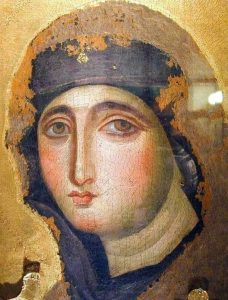This is the last in a four-part series in which we seek to see anew the incarnation of Jesus through the eyes and body of a woman, Mary the mother of Jesus.
Mary went through a great deal just to get to this point. She hears from an angel of her own virginal conception of a holy child, misses her period, grows a child in her body, travels to Bethlehem, gives birth away from family without the safety of a birth plan, and she nurses her infant son to keep him alive. So much depended on her.
It’s not hard to think how uncomfortable she may have felt in her own body or how she carried anxiety that one wrong step could undermine the well-being of herself or her child. Being a new mother must have added another layer of complexity and worry.

Psalter, England, East Anglia or London, ca. 1300-1310. The Morgan Library and Museum. Note that Mary’s sorrowful face turns away from Jesus and Joseph.
All through a veil of tears, “Was that supposed to happen?” was most likely the question she asked herself, like many first-time mothers.
When Mary continued to bleed for weeks after birth. Was that supposed to happen? When Jesus’ umbilical cord stump turned black and fell off. Was that supposed to happen? When her nipples cracked and bled. Was that supposed to happen?
Was Jesus getting enough milk, why is his poop yellow? Projectile spit up? How many diapers? When will he sleep? Do we really have to get him circumcised? Is it bleeding? Was that supposed to happen?
If Mary was isolated from her family, having traveled to Bethlehem, we can imagine these questions would be even more difficult to answer. More tears surely were to come.
We know the trauma of birth is physically and mentally taxing for women. Our bodies need to heal. Our minds need rest and time to heal and process. Yet we have a newborn to care for. It is an unequally vulnerable time for women. Our hormones are working hard to help us produce milk if we are nursing and to heal our bodies. Our minds are just trying to keep up and survive. It should be no surprise that we shed some tears.

Christ in the House of Martha and Mary by Jacopo Robusti Tintoretto.
The tears of women, like the bodies of women, make many of us uncomfortable.
Yet, Jesus wept.
Yes, Jesus cried tears as a baby. There was no silent night, and I’m sure Mary cried right along with him at times.
Jesus cried tears as an adult. Scripture makes sure we know Jesus was human in that way as well.
In the Gospel of John, Jesus is called to the house of Mary and Martha to attend to their brother, Lazarus, who is ill. When Jesus arrives, Lazarus has died, and Jesus weeps.
Jesus weeps, he cries for his friend who has died and for his friends Mary and Martha who have lost their brother. This is significant because it tells us Jesus has close relationships outside his family and he is affected by these human relationships. The death of a friend affects him in a real human way. He is overcome with grief, and he weeps real tears.
Jesus knows the pain and grief of humanity. He experienced it and allowed it to overflow out of his body in the form of tears.
I recently watched the movie Quiz Lady (spoiler alert) starring Awkwafina and Sandra Oh as sisters. We learn near the beginning of the movie the main character, Anne, was so uncomfortable in her cousin’s house where she and her older sister were sent to live, she was unable to poop for many weeks. When Anne finally felt her stomach begin to gurgle, she panicked, dug a hole in the backyard, emptied her stomach of weeks of poop and covered the hole back up. Of course, it was discovered the next morning. The years of shame from that day continued to make her uncomfortable in her own body and her own family. Little did she know her sister took the blame for her until years later, which we discover at the end of the movie.

Agiosoritissa Icon (Maria Advocate), Anonymous, 6th century. One of the oldest known images of Mary. This type of icon is of Mary alone, without Jesus. Medieval tradition is that the icon was painted by the author of the Gospel of Luke.
I am afraid we have made women horribly uncomfortable and unsafe in their own bodies. Tears are a natural action for the human body, after all. In the same way menstrual blood, vulvas and breasts are used to shame women, so are tears. It is all tied up in the same patriarchal package. In the “If you would just smile more and cry less” statements, for example. In the same way we are not allowed space to be angry, for often anger is unresolved or unrealized sadness, we are not allowed to cry. Or if we are allowed space to cry, we are not allowed to express anger, anxiety or depression after birth or any other time and re-enter the work force as full humans. It is fine only if you keep that emotional baggage at home.
I recall the unloading of emotion I have felt at many darkest night worship services in December even though I was leading in worship myself. I somehow gave myself permission, the space to grieve, to weep and to allow others to see me do so. It is not often we see our pastors weep from the pulpit. It is not often we see women lead in worship with tears running down our faces. When we do experience those moments, I pray whether we are the ones weeping or the ones viewing the weeping we will hold space for the tears. We can hold space for weeping in keeping with the embodiment of the incarnation. Especially women who are pastors who have very little public space to grieve.
Simon told Mary in the temple, in Luke’s Gospel, that “a sword will pierce your own soul, too.” She knew then her tears would fall regarding her son, just not when. Perhaps she wept that very day upon hearing those words. I can imagine it was so.
A glimpse of sorrow, a foretelling of the tears and desperation that would come for a mother and a child.

Madonna with sword piercing her soul. Photograph by the author of a painting from an art restoration project in Memphis, TN. Artist and dating unknown.
To be incarnate people, to live as people embodied like Jesus, we must weep like Jesus. We share in the shedding of tears, for we know the pain and sorrow of this world. Shared pain does not take the sorrow away but does lessen the burden somewhat. Ignoring pain only increases its power. We share grief with one another in community, in kin-dom. We depend on each other because we are the body of Christ. We comfort each other, sit with each other’s pain, see each other’s pain without shying away because we are brave and because we are free, because love is stronger than death.
That is the gift of tears.
Vulnerability allows us to be truly seen and heard.
We give power to each other, a mutuality in which tears can be shed.
Jesus wept for and with his friends because he was willing to be vulnerable, he trusted them with his deepest emotions. He showed them with his body, like Mary had shown him with her body, what trust and vulnerability looks like.
May we be people who live by the glory and miracle of the incarnation. The messy, bloody, painful, milk gorged, tearful coming of Jesus among us. God has shown us what is good and wondrous through this holy healing child of Mary.
May it be so in each of our lives.
Many waters cannot quench love,
neither can floods drown it.
If one offered for love
all the wealth of one’s house,
it would be utterly scorned.
— Song of Songs 8:7
How we see Advent through the eyes, through the body of Mary, colors our experience anew:
Blue tears of sorrow: For the tears of sorrow, grief and depression, we make space for our bodies to cry. We will not shy away from the need for mental health care at any time in our lives and especially at vulnerable times. Humans must cry, for there is suffering in the world and in our very own bodies. We are in pain in very real and tangible ways — physical and mental.
Blue tears of joy: For the tears of joy coupled with pain, we also make room. There is no black or white way to see or live in the world. We see it in color for our joy is only complete when we have also grieved.
Blue tears of empathy: We experience each other in kin-dom living. Weeping with each other in sorrow and joy in a wider and stronger love. Empathy allows us to embrace the other, to love our enemies, to know people on a deeper, fuller level in which we give power away and become stronger together. May we be grateful for the tears shed that show us true comfort for God’s people when we are seen and heard by each other.
Blue tears of reflection: May we be incarnate people, for God is truly with us. God is here now, within our own bodies that reflect God. God is within the female body, the male body and the body of every gender in between. Do not mistake the transformative power of the incarnation, the ability of our God to come into a body of a woman and a vulnerable child. I pray this power will transform each of us into people who live and love like Jesus and like Mary. May it be so. Amen.
But when the fullness of time had come,
God sent his Son, born of a woman, born under the law,
in order to redeem those who were under the law,
so that we might receive adoption as children. —Galatians 4:4-5

Georgia O’Keeffe, Lake George (formerly Reflection Seascape), 1922
Zion is a woman
weeping for her brother
Crying for her child
Zion, she’s not perfect
But she loves him all the more
Her only love
Only love
Holy and honest”
— Zion is A Woman by Van Plating
Julia Goldie Day is an ordained minister within the Cooperative Baptist Fellowship and lives in Memphis, Tenn. She is a painter and proud mother to Jasper, Barak and Jillian. Learn more at her website or follow her on socials @JuliaGoldieDay.
Previous article in this series:


